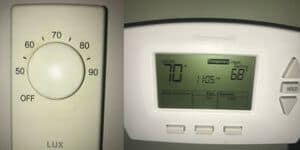Buying a House with Electric Heat

Many home buyers will fall in love with a home, but when they find out the home has electric heat, they are left with what they believe to be a difficult home buying decision. Electric heat has the perception of being very expensive and inefficient, but with the right equipment and planning, it can actually be cheaper than some of the alternatives
Most modern homes that have electric heat are using electric baseboard heat. If the home you are looking at has an older style electric heating system, then it may also come with other problems such as poor insulation. So, for the purpose of this article we will focus on the most common type of heat found in homes today which is electric baseboard heat.
Contact us for an Extremely Competitive Rate Quote
Should I Buy a House with Electric Heat?
Buying a house with electric heat can be an excellent choice if the heating units are up to date with multiple zones, the home is well insulated, and you keep the thermostats at an average of 68 degrees.
How Does Electric Baseboard Heat Work? 
Electric baseboard heaters are placed in strategic locations in each room such as beneath windows. The electric current flows through the heating element and out to the fins which will radiate the heat into the room.
There are no fans to assist in moving the warm air so baseboard heat relies upon the natural movement of air to take the radiant heat from the fins and move the heat across the room.
Is Electric Heat Expensive?
Electric heat when used with modern technology in a well-insulated multi thermostat zoned home can be as efficient as gas or oil heat. However, when you have electric heat combined with an older poorly insulated home, then electric heating bills can be expensive.
Electric Baseboard Heat Cost per Month
The monthly costs to heat a 2,000 square foot home with electric heat can be anywhere from $200-$400 during the winter months. There are so many factors which can impact your costs to heat your home including the following:
- How well the home is insulated
- Position or location of the baseboard heating units
- Where the home is located and the average temperature in the winter
- If each room has its own thermostat to control the baseboard heating unit in that room
- The temperature you keep the thermostats set
- Lowering the heat temp or turning the units off when you are not at home or sleeping at night
- Whether the home is exposed to sun or shaded by trees
Pros and Cons of Buying a House with Electric Heat
Pros
-
- Cost of electricity remains relatively stable
- Electricity is a common source of energy and readily available
- Rooms heat up quickly
- Baseboard electric heat fixtures last a long time
- Baseboard electric heat fixtures are inexpensive to replace
- The addition of solar panels can offset heating costs
Cons
-
- Electric bills can be extremely high
- Electric is a dry heat and a humidifier is often needed in the home
- Homes with electric heat can be harder to sell at times
Tips to Make Your Electric Baseboard Heated Home Energy Efficient
Insulation – Insulating your home properly is going to help keep your heating costs down regardless as to whether you are using electric heat, gas, or oil. Warm air can escape through the smallest cracks around your light switches, outlets and recessed lighting. These cracks may also let cold air in. Spend a day in the fall to find all of the places where air can travel and use spray foam insulation to seal everything.
Place the baseboard heaters under your windows – Windows are an area of the home where cold air can radiate in. If there is a bit of a draft, placing the baseboard heaters beneath the windows will give you a chance to actually heat that cool air coming in from the outside radiating off of the glass.
Keep your thermostat at 68 degrees – There are multiple studies that show costs rising significantly for every degree above 68 degrees that you have your thermostat set at.
Use a thermostat for each room – There will be rooms in the home where you do not spend much time. It could be a spare bedroom or even a finished basement. What you do not want to do is spend money heating rooms if nobody is there to feel the warmth because your furniture does not care what temperature the room is.
It is recommended to wire the baseboard heating units in each room to their own thermostat. This will enable you to control the temp for each room independently and only heat rooms that are needed. For example, you may want your bedroom at night to be 67 degrees but the rest of the rooms in the home can be turned down to 60 degrees or less.

Use a separate humidifier – Earlier we mentioned keeping your thermostats set at 68 degrees. A home with dry heat will feel colder than a home that has some humidity added to the air. If you plug in a portable humidifier and let it run for the winter, the home will actually feel warmer even though you still have the thermostat set at 68 degrees.
Clean the baseboard heating fins before each season – The fins are what actually radiate the heat from your baseboard heater. They often collect dust and as a result become inefficient. Just before the heating season, it would be a good idea to install a brush attachment to your vacuum and remove the dust from the fins. The unit will run more efficiently and will likely save some money.
 Add solar panels – A great way to lessen the fear of buying a house with electric heat is to install solar panels. Although solar panels do not generate the same power as they do in the summer, you can offset some of your electric costs in the winter too. Many people who live off the grid use a combination of solar panels and electric heat.
Add solar panels – A great way to lessen the fear of buying a house with electric heat is to install solar panels. Although solar panels do not generate the same power as they do in the summer, you can offset some of your electric costs in the winter too. Many people who live off the grid use a combination of solar panels and electric heat.
Gas or Propane vs Electric Baseboard Heat
If you are shopping for a home, then you may be searching in a neighborhood that has a choice of either electric heat or gas. There are many neighborhoods that do not have gas lines which means you could be deciding whether propane is a better alternative to electric heat.
Gas forced air heat may be less expensive that electric baseboard heat. However, the cost differential per month is very close and the cost to replace the gas furnace can be very expensive. That is one of the benefits of electric baseboard heat which is how cheap it is to replace a unit in a room.
Propane is probably the worst option to heat your home really because of the effort and cost associated with having a company come out to fill the propane tank when it is empty. Plus, you have to maintain a heating system and potentially replace a large ugly propane tank in your yard one day.
Recommendation
We suggest that if the home was built within the past few decades that you proceed with buying the home that has electric heat. If this is the home that you truly want, you can always do a better job of insulating and add individual thermostats later if the home does not have them already.
If the home is much older or even historic, then you should potentially be concerned about much higher energy bills regardless as to whether it has electric heat.
Click to speak with a lender who can help finance your home with electric heat.
Related Questions
Does Oil Heat use Electricity?
Oil heat does use electricity to power the oil burning boiler if the home has baseboard heat, plus a blower fan if the home is using forced air heat.
How Much Does it Cost to Install Electric Baseboard Heat?
Each baseboard unit will cost you anywhere from $30-$90 depending upon the length. Then, if you need an electrician to install the unit for you, it could be an additional $100 – $150 each for the installation. Plus, a basic thermostat for electric baseboard heat will likely cost about $30 each.
Helpful Articles
Should I Buy a Home in a Flood Zone?
Should I Buy a Home with an Old Septic System?
Should I Buy a Home with Aluminum Wiring?
